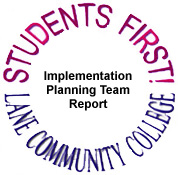| Lane Home Page | Search Lane |
| Website Accessibility |
|
Table of Contents | Students First! Page This chapter describes the framework used by the Students First! Implementation Planning Team to evaluate the recommendations. The framework consists of five dimensions of an organization that are impacted by process redesign - people and organization, cross-functional workflow, technology, physical infrastructure, and policies and procedures. Within the context of the five dimensions, the team examined the current situation and proposed solution presented in each recommendation. The five dimensions are defined below. People and Organization Defined as key elements for an organization's growth and ability to create a team-based, multi-skilled workforce. People refers to the individuals who perform the work and their roles and responsibilities within a service unit and the larger organization. The team identified training requirements to support the continuous development of skills, outlined criteria for evaluating individual and team performance, defined job responsibilities and the requisite skills and characteristics, and reviewed collective bargaining issues to be addressed by Lane leadership. Organization refers to the organizational reporting structure that supports individuals and their related service units. The team identified the elements of an organizational structure necessary to support a team-based approach to service delivery and examined issues related to control, accountability, and authority. Cross-Functional Workflow Defined as the interaction between units in support of a process without regard for traditional functions or boundaries. Refers to the relationships between various functional units that may handle different steps in a process. The team identified opportunities to establish new alliances and strengthen relationships so that work moves in a continuous flow and activities are closer to the customer (i.e., student, employee, or other service recipient). Technology Defined as the crucial enabling factor that provides for broader access to information, supports improved timeliness in processing, and facilitates communication with students and between providers of services to students. Refers to computer software, hardware, and programming issues and requirements. The team identified current and future system capabilities to support service delivery options (self, assisted, directed) and meet information requirements. The team also explored the use of non-computer related technology (i.e., telephone, video, cable television) to deliver services and disseminate information. Physical Infrastructure Defined as the physical space, environment, and equipment needed to support cross-functional processes and workflow, technology improvements, and a team-based workforce. Refers to current constraints and expected changes in the infrastructure. The team identified short and long-term opportunities for improvements and monitored the bond process to ensure those recommendations complemented the redesign recommendations. Policies and Procedures Defined as the internal and external controls that may hinder or support efforts to redesign processes and effectively use technology and skills. Refers to policies, procedures, and values that Lane will need to establish or revise to accommodate new ways of managing, conducting business, and delivering service. The team identified accountable parties who will endorse and approve any changes in college policies, procedures or philosophy. The team also identified external and contractual relationships that need to be re-examined. The team's findings are included in Appendix A. |
>> Return to Lane's Home Page >> Return to Process Redesign Project Main Page >> Return to top of page Lane Community College - Process Redesign Project 4000 East 30th Avenue, Eugene, OR 97405 Please direct comments about this site to webmaster@lanecc.edu Revised 12/2/96 (llb) © 1996-present Lane Community College |
 Chapter Two
Chapter Two